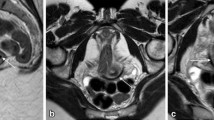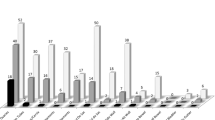Abstract
Purpose
The purpose of our study is to assess the utility of pelvic magnetic resonance imaging (MRI) in the event that either one or both ovaries are not visualized by pelvic ultrasound.
Materials and methods
This HIPAA-compliant retrospective study was approved by our local institutional review board and informed consent waived. 1926 pelvic MRI examinations between March 2007 and December 2011 were reviewed and included if a combined transabdominal and endovaginal pelvic ultrasound had been performed in the preceding 6 months with at least one ovary nonvisualized. Ovaries not visualized on pelvic ultrasound were assumed to be normal and compared with the pelvic MRI findings. MRI findings were categorized as concordant or discordant. Discordant findings were divided into malignant, non-malignant physiologic or non-malignant non-physiologic. The modified Wald, the “rule of thirds”, and the binomial distribution probability tests were performed.
Results
255 pelvic ultrasounds met inclusion criteria with 364 ovaries not visualized. 0 malignancies were detected on MRI. 6.9% (25/364) of nonvisualized ovaries had non-malignant discordant findings on MRI: 5.2% (19/364) physiologic, 1.6% (6/364) non-physiologic. Physiologic findings included: 16 functional cysts and 3 hemorrhagic cysts. Non-physiologic findings included: 3 cysts in post-menopausal women, 1 hydrosalpinx, and 2 broad ligament fibroids. The theoretical risk of detecting an ovarian carcinoma on pelvic MRI when an ovary is not visualized on ultrasound ranges from 0 to 1.3%.
Conclusion
If an ovary is not visualized on pelvic ultrasound, it can be assumed to be without carcinoma and MRI rarely adds additional information.


Similar content being viewed by others
References
Fleischer AC, McKee MS, Gordon AN, et al. (1990) Transvaginal sonography of postmenopausal ovaries with pathologic correlation. J Ultrasound Med 9:637–644
Fishman DA, Cohen L, Blank SV, et al. (2005) The role of ultrasound evaluation in the detection of early-stage epithelial ovarian cancer. Am J Obstet Gynecol 192(4):1214–1221
Van Nagell JR Jr, DePriest PD, Ueland FR, et al. (2007) Ovarian cancer screening with annual transvaginal sonography: findings of 25,000 women screened. Cancer 109(9):1887–1896
DiSantis DJ, Scatarige JC, Kemp G, et al. (1993) A prospective evaluation of transvaginal sonography for detection of ovarian disease. AJR 161:91–94
Hartge P, Hayes R, Reding D, et al. (2000) Complex ovarian cysts in postmenopausal women are not associated with ovarian cancer risk factors. Preliminary data from the prostate, lung, colon, and ovarian cancer screening trial. Am J Obstet Gynecol 183:1232–1237
Adusumilli S, Hussain HK, Caoili EM, et al. (2006) MRI of sonographically indeterminate adnexal masses. AJR 187(3):732–740
Kinkel K, Lu Y, Mehdizade A, Pelte MF, Hricak H (2000) Indeterminate ovarian mass at US: incremental value of second imaging test for characterization—meta-analysis and Bayesian analysis. Radiology 236:85–94
Agresti A, Coull BA (1998) Approximate is better than “exact” for interval estimation of binomial proportions. Am Stat 52:119–126
Hanley J, Lippman-Hand A (1983) If nothing goes wrong, is everything alright? JAMA 249(13):1743–1745
Levine D, Brown DL, Andreotti RF, et al. (2010) Management of asymptomatic ovarian and other adnexal cysts imaged at US: Society of Radiologists in Ultrasound Consensus Conference Statement. Radiology 256(3):943–954
Henschke CI, Yankelevitz DF, Naidich DP, et al. (2004) CT screening for lung cancer: suspiciousness of nodules according to size on baseline scans. Radiology 231(1):164–168
MacMahon H, Austin J, Gamsu G, et al. (2005) Guidelines for management of small pulmonary nodules detected on CT scans: a statement from the Fleischner society. Radiology 237:395–400
Khan A, Sultana K (2010) Presenting signs and symptoms of ovarian cancer at a tertiary care hospital. J Pak Med Assoc 60(4):260–262
Eltabbakh GH, Yadav PR, Morgan A (1999) Clinical picture of women with early stage ovarian cancer. Gynecol Oncol 75:476–479
Goff BA, Mandel LS, Melancon CH, Muntz HG (2004) Frequency of symptoms of ovarian cancer in women presenting to primary care clinics. JAMA 291(22):2705–2712
Age-Adjusted Invasive Cancer Incidence Rates 2004–2008 Ovarian Cancer (2012) Centers for disease control and prevention website. http://apps.nccd.cdc.gov/uscs/cancersrankedbystate.aspx. Accessed 5 December 2012
Goff BA, Mandel LS, Drescher CW, et al. (2007) Development of an ovarian cancer symptom index: possibilities for earlier detection. Cancer 109(2):221–227
Sharma D, Dahiya K, Duhan N, Bansal R (2011) Diagnostic laparoscopy in chronic pelvic pain. Arch Gynecol Obstet 283:295–297
Rodgers S, Kirby C, Smith R, Horrow MM (2012) Imaging after cesarean delivery: acute and chronic complications. RadioGraphics 32:1693–1712
Abrao MS, Goncalves M, Dias J, et al. (2007) Comparison between clinical examination, transvaginal sonography and magnetic resonance imaging for the diagnosis of deep endometriosis. Hum Reprod 22:3092–3097
Bazot M, Bornier C, Dubernard G, et al. (2007) Accuracy of magnetic resonance imaging and rectal endoscopic sonography for the prediction of location of deep pelvic endometriosis. Hum Reprod 22:1457–1463
Grasso R, Di Giacomo V, Sedati P (2010) Diagnosis of deep infiltrating endometriosis: accuracy of magnetic resonance imaging and transvaginal 3D ultrasonography. Abdom Imaging 35:716–725
Cicchiello L, Hamper U, Scoutt L (2011) Ultrasound evaluation of gynecologic causes of pelvic pain. Obstet Gynecol Clin N Am 38:85–114
Hunn J, Rodriguez GC (2012) Ovarian cancer: etiology, risk factors, and epidemiology. Clin Obstet Gynecol 55(1):3–23
Acknowledgment
The authors thank Dr. John Ward for his assistance with the statistical analysis.
Author information
Authors and Affiliations
Corresponding author
Additional information
The opinions and assertions contained herein are those of the authors and should not be construed as official or as representing the opinions of the Department of the Army or the Department of Defense.
Rights and permissions
About this article
Cite this article
Lisanti, C.J., Wood, J.R. & Schwope, R.B. Nonvisualization of the ovaries on pelvic ultrasound: does MRI add anything?. Abdom Imaging 39, 162–167 (2014). https://doi.org/10.1007/s00261-013-0046-0
Published:
Issue Date:
DOI: https://doi.org/10.1007/s00261-013-0046-0




